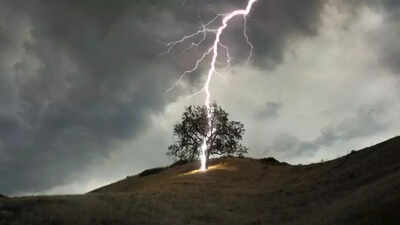320 million trees die each year from lightning, and climate change is making it worse |

Every year, lightning kills around 320 million trees across the globe, not with raging wildfires but through direct strikes that often go unseen. The trees don’t always fall dramatically; many die slowly from internal damage, their trunks fried from the inside out. In dense forests, these deaths blend into the background, unnoticed by satellites or the human eye. While wildfires make headlines and scar landscapes, lightning-induced tree deaths are scattered and silent, but the impact is anything but small. Now, for the first time, researchers have created a global model to calculate the scale of this damage. The results suggest we’ve been drastically underestimating lightning’s role in shaping forest ecosystems and climate dynamics.
How lightning quietly kills millions of trees
Most people think of lightning as a momentary spectacle—a flash, a thunderclap, and it’s over. But in forests, lightning is an invisible predator. When it strikes a tree, the damage isn’t always external. The bolt can superheat the sap, explode tissue from within, and trigger a slow decline. In tropical and temperate forests alike, these slow deaths often escape detection. Without charred scars or visible damage, the impact is difficult to trace. For decades, scientists lacked the tools to measure how many trees were being lost this way—until now.A research team from the Technical University of Munich set out to fill the data gap. They developed the world’s first global model of lightning-induced tree deaths by combining satellite data, field studies, and global lightning distribution patterns. The result was eye-opening: 320 million trees per year are killed directly by lightning. That number does not include additional trees lost in fires started by lightning. The researchers also identified high-risk regions, particularly in the Amazon and Congo Basin, while warning of growing threats in Canada, Russia, and parts of the United States as climate change increases lightning frequency.
Tree deaths from lightning are a major carbon emission source
When trees die and decompose, they release carbon dioxide—and lightning is a growing contributor. The study found that these deaths emit between 0.77 and 1.09 billion tons of CO₂ per year, nearly matching the 1.26 billion tons emitted annually by wildfires burning live vegetation. Considering total wildfire emissions (including deadwood and soil carbon) reach around 5.85 billion tons, lightning’s contribution is far more significant than previously recognized. As lightning strikes increase and trees struggle to regenerate, the planet’s ability to store carbon is threatened.
Climate change is supercharging lightning and risking forest health
Climate models project that lightning will become more frequent in the coming decades. While tropical forests currently suffer the most from lightning strikes, northern forests in temperate and boreal zones are also at risk. These ecosystems, already weakened by drought, pests, and warming, may face longer recovery times since trees in colder regions grow more slowly. The shift could permanently alter forest composition and resilience in areas not historically adapted to high lightning activity.Unlike wildfires, which leave visible scars, lightning strikes kill trees quietly. A single bolt may take out one tree at a time, with no smoke, no char, and no sign. These deaths are dispersed, subtle, and easy to overlook—making it harder for scientists and satellite systems to track. Yet the ecological consequences are vast. Trees are foundational to biodiversity, climate stability, and carbon storage. Losing hundreds of millions of them annually to an invisible force means rethinking how we model and manage forests worldwide.The death of 320 million trees each year due to lightning strikes is equivalent to the loss of about 8,000 square kilometers of forest approximately — an area larger than Sikkim, over five times the size of Delhi, and nearly ten times that of New York City. And still, these losses go largely unrecorded. As the planet warms and lightning becomes more frequent, this overlooked threat is likely to grow. Forests are dying in silence, and unless we start paying attention, we risk losing one of our most vital defenses against climate change—one bolt at a time.





